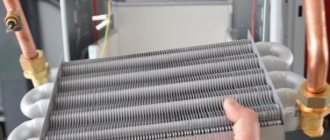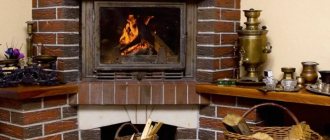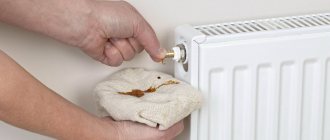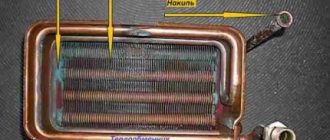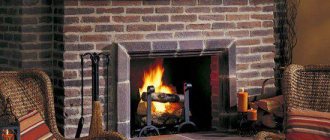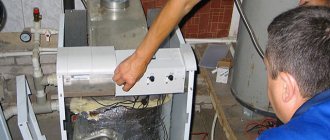When you have a beautiful wood-burning heater in the living room, the question often arises of how to clean the glass of the fireplace from soot. Without special skills and knowledge of methods, problems arise, accompanied by damage to the structure and serious financial costs. We suggest getting rid of worries and cleaning the surface the first time. Below in the article there are quite effective methods, everyone can independently choose the most convenient one for themselves.
Cleaned glass of a fireplace in the house Source custommade.com
Reasons for the appearance of soot on glass
Carbon deposits on the glass door of a fireplace stove appear due to the influence of various factors. Most often this is the choice of the wrong fuel, but what if the only resource is provided for heating, because it is also necessary to understand the reason. We suggest going through the details in this section.
For gas fireplace
When the heating source is blue fuel, the glass door becomes less clogged. If soot does appear, it’s time to think about cleaning the injectors and burners. The jets may be in the wrong position and need to be adjusted. Both factors lead to a violation of the proportion of fuel and air in the chamber. The result is contamination of the walls.
Gas fireplace with glass doors installed Source custommade.com
Reasons for Propane Furnaces
More problems arise with propane fireplaces, since the formation of soot in them is quite intense. Here we are talking similarly about clogged burners or damage to the chamber. It is possible that the fireplace is fueled with low-quality fuel. This can be assessed by the moment at which dirt began to appear on the sashes.
Problems with wood burning fireplaces
Wood fuel is considered the most natural and safest for the indoor atmosphere. This only applies if the fuel is selected correctly. It is better to order the product from one professional supplier, or even better from the fireplace manufacturer. They often provide the correct fuel. Logs that are too damp and resinous are the main sources of soot. Be sure to check that there is enough oxygen entering the firebox, as without this there will be increased smoke and dirt on the glass.
Wood-burning fireplace with slightly smoked glass Source bricookcorigliano.it
Symptoms of a blocked chimney
It is not difficult to guess that the chimney system is clogged. This is clearly indicated by the sharply decreased draft in the firebox and a noticeable cooling in the rooms.
Problematic primary ignition of the fuel resource and random flame extinction also indicate a decrease in the permeability of the channels and a violation of proper air exchange.
If the chimney is cleaned incorrectly, it will lead to additional problems. A technician who does not have the proper experience can seriously damage the pipe and even compromise the integrity of the entire system. The results will be disappointing
A signal that the chimney needs cleaning is a change in the color of the flame in the combustion chamber. A fire that turns a juicy orange color as it burns clearly implies a problem.
This is also evidenced by the unexpected smell that appears, which is uncharacteristic of the normal operation of the firebox.
Cleaning methods: the most budget-friendly
When the question arises of how to clean soot from the glass of a fireplace, everyone tries to save money. Indeed, there are budgetary methods for this purpose; read about the details of their use below.
Ammonia
It is believed that ammonia (ammonia) is a good bleaching agent. It does a good job of removing contaminants such as soot, greasy deposits, and soot. It is considered absolutely safe for glass. To implement it, you need to follow the step-by-step instructions:
- Prepare half a liter of clean water, 1 tsp. ammonia and 1 tsp. vinegar. Mix the ingredients thoroughly and place them in a spray bottle.
- Put on rubber gloves, spread a protective agent on the floor under the fireplace: film, thick fabric, an old towel.
- Spray the mixture onto the contaminated surface and wait until the soot begins to dissipate. This process will take 2-3 minutes.
- Then gently wipe off the stain with a paper towel or soft, non-abrasive cloth. If desired, rinse the glass with water.
- Be sure to wipe the surface dry to remove streaks.
If necessary, the cleaning procedure can be repeated using this method until the soot is completely removed.
Using ammonia to clean fireplace glass Source moyaokolitsa.rf
Our services
Our company has specialists in the maintenance of ventilation and smoke ducts, with the appropriate permits and qualifications. All work is carried out using professional equipment - an installation with a flexible shaft on a mechanical drive. This allows you to quickly and effectively clean a box of any configuration, diameter and material of manufacture, reduce the time and dust of the work process. Additionally, during the cleaning process, the chimney is inspected, damage is identified, which is immediately repaired.
Video description
How to clean fireplace glass in a couple of minutes.
Ash and sponge
This method is considered mechanical, since its implementation requires some effort. But it has good efficiency, although it is considered dirty. To carry out this cleaning option, follow the instructions.
- Prepare a bucket of clean thermal water.
- Lay a protective covering on the floor to avoid staining the finish.
- Wet a sponge and apply ash from the firebox onto it.
- With this mixture, start scrubbing dirty areas on the glass.
- Repeat the procedure until soot and deposits on the surface are completely removed.
- Take a clean sponge and wash the glass until there are no streaks.
- Then wipe dry with a paper towel, removing any remaining soot.
It is not recommended to use this method when trying to clean soot in hard-to-reach places: in the corners of hinges, under the handles. When contaminants accumulate there, smudges will begin to appear from time to time, especially if condensation occurs.
Pros:
- removes dirt from the first application;
- does not require the addition of special compounds;
- budget.
Minuses:
- the need to exert strong physical pressure.
Creating a strong flame in the firebox
When using this method, you should ensure that the fuel is suitable for the procedure. That is, it was not a pollution enhancer. It is enough to light a strong flame in the firebox and let it burn for several minutes. As a result, not only does the carbon deposits on the glass door burn out, but the chimney system is also cleaned.
Using a strong flame in a fireplace insert to clean glass Source krot.info
As such, there are no instructions for using this technique; there is no need to clean the glass surface before performing it.
Pros:
- all surfaces are cleaned;
- does not require physical impact;
- safe for the door.
Minuses:
- It doesn’t always work, and sometimes it contaminates the coating even worse.
Combustion as a way to clean the glass doors of a wood-fueled fireplace Source sulaplanet.com
Scraping
Such an event is carried out with the obligatory use of a special tool - a scraper. The use of any improvised means is strictly prohibited. Instructions for this tool are included in the package. The main condition is not to overdo it with pressure, so as not to damage the glass structure.
Cleaning a fireplace with a glass door from soot Source pro-fermer.ru
It should be noted that removing soot using a scraper is possible only in extreme cases. For example, if previous methods were not successful. Scraping soot residue from the glass fireplace door may cause the tool to turn incorrectly. This will cause scratches. Such damage can lead to destruction of the surface during kindling, since any scratch causes a violation of fire resistance and the glass breaks.
Pros:
- the scraper is specially designed for this purpose;
- the method is safe for health (not accompanied by toxic odors);
- Suitable for old carbon deposits.
Minuses:
- It’s better not to take on a job without a certain skill.
Here are the most budget-friendly methods that will tell you how to clean soot from the glass of a fireplace. All options will cope with the task perfectly if the soot has accumulated in just a few kindlings. Please note that the longer dirty glass sits, the more difficult it will be to clean it by any means.
Using a fireplace scraper to clean a glass door Source hoff.ru
Is it necessary to clean
The answer is clear - yes, definitely. Let's figure out what a chimney is? As the name implies, this is a kind of device for the passage of smoke. It is a vertical channel with a round or rectangular cross-section, designed to discharge fuel combustion products into the atmosphere. The chimney creates a natural draft, with the help of which the necessary air enters the firebox, and gas is removed from the firebox.
The fuel does not burn completely without a residue; soot rises into the chimney along with the smoke. It settles on the walls of the chimney, forming a coating that becomes thicker over time. The diameter of the pipe decreases, and the draft decreases accordingly; the chimney ceases to perform its main function.
To prevent this from happening, it is necessary to periodically clean the chimney of soot. Previously, when stove heating was everywhere, the profession of a chimney sweep was very popular. There are still professional chimney sweeps, but it is not at all necessary to resort to their services; you can do it on your own.
Methods using household chemicals
Budget cleaning options have run out, and if they don't help, it's time to resort to more aggressive methods. To do this, you need to use special compositions from household chemicals. Of course, you can order special preparations for caring for fireplaces. Their approximate price is 1500-2500 rubles.
But you can also save money, since general-use products are suitable for removing soot from glass. Let's look at the best options:
- Comet in spray and powder form. All you need to do is wet the glass surface with warm water, wet a clean sponge and apply the chemical to it. Then clean the glass in a circular motion and wipe dry.
- Cif cream. An ideal gentle product used for enamel coatings. It’s also great for glass, as it quickly removes soot and grease deposits on fireplace doors. The cleaning process is similar.
- Any composition for glass and mirrors. There are special sprays on sale that contain the familiar ammonia. It is enough to spray the chemical on the coating, and after a few minutes all the soot can be removed with a damp cloth.
- Dish gels: Ferry, AoS and others. To clean glass from soot stains, just take a dry, clean sponge (just be sure to come from the package, it should not contain grease from dishes). Lightly moisten it with water and then squeeze out a few drops of detergent. Next, you should make a generous amount of foam and wipe the glass sash with it. Finally, remove any residue with a dry cloth.
- "Antifat." This chemical composition is sold in the form of a spray, and when sprayed onto the surface, it generates active foam, which is the source of cleaning carbon deposits. This product for cleaning fireplace glass from soot additionally removes oils and fats that could be formed from products of improper combustion.
Log "Chimney Sweep"
Among the chemical methods of combating deposits, the Chimney Sweeper log is especially popular. The shape of the product is not much different from wooden firewood. Available in several versions. For standard stoves and home fireplaces, a block weighing a little more than a kilogram is suitable; for small-sized potbelly stoves, a log weighing from 600 to 800 grams is suitable.
The composition of Chimney Sweep includes urea, coal wax, sodium salt, sawdust, ammonium sulfate and other chemicals that, at the concentration specified by the manufacturer, do not pose a danger to humans.
The log is placed in the oven along with regular firewood or hot coal. Burning time varies from 45 minutes to one and a half hours. After the stove burns out, the ash from the Chimney Sweeper is left inside for a few more days. The final effect of using artificial logs appears after 1-2 weeks. During this time, the soot softens, separates from the walls and flies down.
Treatment must be carried out before and immediately after the heating season. If some of the deposits cannot be removed, mechanical cleaning is used to help Chimney Sweep.
Selection of household chemicals
Before answering how to clean the glass of a fireplace, you must first decide what kind of product is needed for this purpose. For example, if you decided on household chemicals, you must understand what characteristics these products must meet:
- composition (the presence of alkali is required!);
- compatibility with the materials from which the fireplace is made;
- the recommendations from the fireplace manufacturer contain permission for use;
- there are instructions for use;
- Recommendations for compliance with precautionary measures are prescribed.
The consumer should read all this information on the packaging. The words of a sales consultant in this case will not be enough.
Kitchen cleaning gel can be used for fireplace stove glass Source skladupakovki.rf
How to understand the frequency of cleaning
The most important thing is that the fireplace does not need to be brought to a state where only replacement or repair can help it. After all, a fireplace is, in a sense, an “organism”, so any small problem can later develop into a big one. Here's what the frequency of cleaning depends on:
- on the frequency of use (the more often the fireplace is lit, the more clogged it will become, so it is best to analyze your needs and decide based on them how often you need to clean the fireplace);
- on the type of wood used (different types of firewood contain different substances and burn differently, leaving different residues on the walls of the firebox and chimney, so this greatly affects the need for cleaning the chimney);
- method of cleaning and prevention (how owners clean and carry out preventive actions is also very important for determining the frequency of cleaning activities, since any method has both advantages and disadvantages).
In order for the fireplace to be enjoyable for a long time, it must be looked after properly. Only then will the atmosphere in the living room or dining room be cozy and inviting for calm.
Permitted forms of purchased chemicals and tips
Since glass is considered the most fragile material, it is necessary to use safe compounds that are not abrasive. The most gentle forms are considered to be spray, gel, granules, liquid, ointment (in tubes).
When getting acquainted with such modifications of cleaning products, it is recommended to first try them on another surface that you don’t mind ruining. It is important that the processing does not lead to the formation of nicks and scratches.
Remember that the composition of the declared products must be balanced! A deficiency of one or another component or too high a concentrate can lead to damage to the glass coating.
Dishwashing detergent will help get rid of carbon deposits on the glass door Source onlinetrade.ru
Chimney prevention goals
When cleaning a fireplace, we usually pursue two goals.
- Improved traction. Soot deposits can be quite hard. They narrow the channel, increasing resistance to the passage of gases. The draft deteriorates, which leads to the fireplace starting to smoke and combustion products entering the room.
- Soot removal. Soot contains a toxic substance - creosol. But its danger also lies in the fact that it is a flammable substance. If it ignites, sparks will fly out of the pipe, which can lead to a fire. Burning soot increases the temperature of the chimney material and contributes to its destruction.
Chimney cleaning work
How to minimize the appearance of soot
To slightly reduce the level of soot on the doors, and not have to wonder how to clean the glass of the fireplace, you can try to reduce the amount of dirt formed. To do this, you need to follow a few tips.
- Use only high-quality fuel. Be sure to eliminate the presence of moisture in the firewood. Use deciduous species, since coniferous trees contain a lot of resin, which accumulates on the glass and burns. Such contamination is then very difficult to wash off.
- Wipe down the fireplace door after each fire. This way you will remove a minimal amount of soot every time and deal with the problem in 1-2 minutes. If carbon deposits accumulate, more time and effort will have to be spent.
- When purchasing a fireplace, pay attention to the presence of such an additional function as a self-cleaning door. With this innovation, you will be able to avoid dirty work altogether.
- When starting the slow combustion system, try not to completely shut off the air supply to the firebox. Otherwise, the fuel will begin to smoke rather than burn. With a decrease in heat transfer, much more carbon deposits appear.
Regular maintenance of the fireplace will make it possible to avoid rough cleaning of its surfaces.
Fireplace care option - choosing the right fuel Source gazovshik.pro
Features of mechanical cleaning
Mechanical cleaning of chimney channels is another effective method of removing accumulated soot, soot and tar deposits that reduce the quality of the heating system.
This is done in two ways:
- top;
- lower
Cleaning from above through the roof is carried out only in normal weather conditions and without wind. Requires experience, physical training and compliance with personal safety measures.
The master does all the work while standing on the roof of a residential building. With this option, dirt does not enter the living quarters, but is removed outside using special devices.
Typically, top cleaning is carried out on fine, dry days in the fall before the start of the heating season and in the spring after the end of constant use of the stove or fireplace. This helps keep the chimney in good condition.
Bottom cleaning is carried out through the outlet of the firebox. The operation is safe and does not require being on the roof, but after it a lot of dirt and combustion residues remain in the rooms.
Most often, the lower method is used in winter, when the chimney duct needs to be cleaned, but objective weather conditions do not allow this to be done through the roof.
The main machining tool is a wide brush for round pipes or a stiff brush for square ones.
The work is labor-intensive and requires a certain skill. Many owners prefer not to do it themselves, but entrust it to a professional chimney sweep.
Additional information on cleaning a smoke duct with your own hands is presented in this article.
Useful tips
You can’t do without useful tips in the fireplace business. They will help correct the situation and further prevent the appearance of soot and other waste in the chamber of the heating device. Please note the following points:
- After cleaning the door, wet the sponge with a concentrated soap solution (meaning one that is made not of liquid, but of solid wood). Wipe the glass surface. There will be no immediate effect and after drying, streaks will be visible. But after heating the glass during kindling, it will remain transparent.
- Application of liquid for automotive chrome. If the household has products for cleaning and removing stains from chrome car parts, then you can apply this to the inner surface of the glass after cleaning, and then wipe it dry. The coating will always be clean during lighting.
- "Clean glass" effect. This is a kind of barrier that will prevent the appearance of soot on the inner surface of the door. It is enough to leave a small gap in the upper part above the sash. Air will additionally penetrate through it into the firebox and prevent soot from settling on the coating. But, this procedure must be carried out with each kindling.
If you follow preventive measures, you won’t even have to buy a fireplace glass cleaner.
Regular cleaning of the fireplace insert Source atlantmasters.ru
Cause of pollution
Before answering the question: how to clean a chimney in a bathhouse, stove or fireplace from soot with your own hands, you should understand why soot and tar are formed in the chimney pipe.
The fuel burns and as a result of this process oxidation occurs, which requires oxygen and high temperature. If at least one of the requirements is not met, then soot appears as a result of insufficient oxidation of carbon.
How to understand that it has appeared? Everything is very simple. If the smoke is black, it means there are soot particles in it, but most of it remains on the walls of the chimney.
Soot can form for a number of reasons:
- Damp firewood.
If you throw insufficiently dry, wet firewood into the firebox, then the equipment will have to spend a lot of energy drying it, and as a result, the temperature in the firebox will be lost. The result is underheating of carbon, a large formation of dark smoke into a clogged chimney. Features of heating with wood are described here - Burning garbage. Under no circumstances should you throw plastic or plastic bags into the firebox, otherwise there will be a lot of soot. In addition, a lot of soot is formed if you heat a stove with scraps of plywood, chipboard, or OSB. The glue they contain instantly clogs the chimney - within two months of using such fuel, the chimney can become completely overgrown.
In addition, the amount of soot formed directly depends on the type of firewood used. Tree varieties such as spruce and pine are not the best option in terms of the speed of overgrowing of the chimney. It is better to use oak or deciduous trees, but these species are quite expensive, and not everyone can afford it.
Do folk remedies help to clean the chimney?
Many people are interested in the question: “Are the “old-fashioned methods” of cleaning chimneys effective?” Someone has heard that a pipe can be cleaned by burning aspen or alder firewood, potato peelings, or pouring boiling water. Let's turn to the practical experience of FORUMHOUSE users.
Ildus72
I wonder if if you burn aspen or peel potatoes, can the chimney be cleaned? Or are these fairy tales?
AleshinNikolai
These remedies really work, BUT, only as prevention. If the chimney is clogged and does not draw well, they will not help. Burn them without waiting for soot deposits to accumulate in the pipe.
Ildus72
How to properly burn aspen wood? Separately from laying the main logs or together with the fuel, for example, throwing them in at the end? And I also heard that the chimneys of sauna stoves are cleaned by splashing water into a heated pipe. They say the ferry kicks out soot. Can this be done?
AleshinNikolai
Firewood can be thrown either way. I recommend throwing a mug of starch onto the well-burning firebrands, just be careful - it puffs. I do not recommend cleaning the chimney with steam. Is it dangerous. When steam comes into contact with soot, “water gas” can form and burn. Sudden temperature changes are harmful to the pipe.
supertaxist
And as a preventive measure, once a week I throw a large handful of dried potato peelings onto the coals in the fireplace. Helps.
Brush with weight
Chimney cleaning using various mechanical devices has been known for a long time. It is this method that is imprinted in the folklore of many European countries. Monuments to chimney sweeps can be found not only in the West, but even in Russia
Which once again speaks to the importance of their work. However, let’s not be distracted from the main goal, namely the answer to the question of how to clean a chimney.
For round pipes, a brush is best suited. This is a disc-shaped metal brush that is suspended from a cable or rope. A load is attached to the bottom of the brush - a core or a spherical weight. Other objects can also act as cargo.
But here it is important to remember that you should only use objects with a stable and undisplaced center of gravity. Otherwise, such a load may get stuck in the pipe and then the problem can only be solved by completely disassembling the chimney. . Under the influence of gravity, the brush falls down the pipe
A cable is used for lifting. The core itself (without the brush) can be used to break through dense clogs and plugs. Thanks to the carabiner connections, the brush elements can be quickly separated and assembled in the desired sequence
Under the influence of gravity, the brush falls down the pipe. A cable is used for lifting. The core itself (without the brush) can be used to break through dense clogs and plugs. Thanks to the carabiner connections, the brush elements can be quickly separated and assembled in the desired sequence
Soot fire in a chimney
Look at the photo below.
This is how soot burns in a chimney. An emergency situation can lead to:
- To deformation or destruction of the chimney and the need for expensive repairs.
- To a fire in the house, and if sparks fall on neighboring buildings, then to a fire in outbuildings or a neighbor’s cottage.
Where does the soot in the chimney come from and why does it catch fire? Let's consider the personal experience of a FORUMHOUSE user.
sanic2003
I have a two-story timber house. The house has a regular metal heating stove. Indoors I installed a single-wall stainless steel chimney. From the outside I connected it to a sandwich - an insulated metal chimney with an internal diameter of 115 mm. I heat the stove with birch wood. One day, when half an hour had passed after the first filling, I saw that the chimney, along the entire height of the second floor, was red-hot. This lasted for 5-10 minutes. The chimney crackled inside, then cooled down on its own. But the section of the chimney on the first floor, from the stove to the ceiling, remained in normal condition. What was it? Is it dangerous? What should I do, and do I need to replace the chimney now?
Experienced users of the portal answer questions.
Alexey TeleginExpert on stoves and chimney systems
I think it was the soot burning off. I advise you to carefully inspect the chimney. If there are no deformations, then continue to use it. In the future, I recommend using combustion modes and fuel that does not accumulate soot and cleaning the chimney more often.
A user with the nickname Doctor72 advises sanich2003 to properly clean the chimney mechanically. And prevent the soot from re-igniting. The sandwich will not survive another fire.
sanic2003
Thanks for the advice! They calmed me down. I'll check the chimney and clean it. Tell me if it is possible to use the so-called. Chimney cleaners that come in sachets? Like throwing it into the firebox. It burned out and the chimney was cleaned. Or is it better to take firewood chopped from poplar and properly heat the stove so that all the deposits in the chimney burn out?
Alexey Telegin
Poplar firewood and chemicals are good for prevention, but mechanical cleaning of the chimney is indispensable.
SyslogModerator FORUMHOUSE
sanich2003, I advise you to check the chimney for leaks. Perhaps below, about a meter, there is an air leak. And also, if you use the long-burning mode, then ideal conditions are created on a long section of an uninsulated chimney for condensation to form inside the chimney and unburnt particles of fuel and soot to settle. You cannot always heat the stove intensively. I would replace everything that is higher than the first meter above the oven with a sandwich. You won’t lose much heat, but the chimney will be clean. I know places where stoves are heated with all sorts of rubbish - pine, fir, damp firewood, but the insulated chimney has not required cleaning for more than 10 years.
